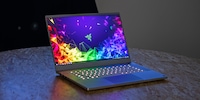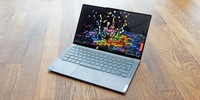

Gaming power at a fair price: Lenovo Legion review
With its black, simple design, this 15.6-inch gaming notebook could also pass for a stylish office laptop. It's equipped with a Core i7, a GTX 1660 Ti and enough RAM and memory. And it has a 144 Hz display.
You can usually tell if a notebook has been designed for gaming. This doesn't apply to the Legion, which looks more like a pretty Thinkpad. It looks like an office device, at least on the outside. The rather poor battery life and its weight of 2.3 kg speak against this. But when it comes to gaming, you can't go wrong: this device has plenty of power.

The technical details:
- Intel Core i7-9750H
- Nvidia GTX 1660 Ti
- 16 GB RAM (SO-DIMM, DDR4-2666, 2 x 8 GB Ramaxel RMSA3260ME78HAF)
- 256 GB SSD (M.2 2280, PCIe 3.0 x4, SKHynix HFS256GD9TNG-L3A0B)
- 1 TB HDD (SATA-600, 7200 RPM, Seagate ST1000LM049-2GH172)
- 15.6” Full HD IPS display with 144 Hz refresh rate (anti-glare)
- Loudspeaker, microphone and 720p front camera
- Lithium-ion battery with 57 Wh
- Windows 10 Home
Simple gaming design with plenty of connections
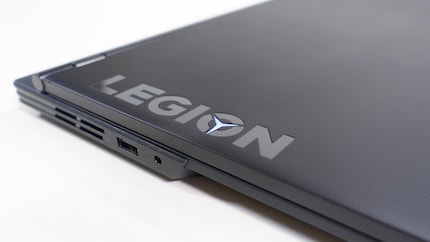
When it comes to the design of this notebook, the only thing that alludes to gaming is a white illuminated element in the letter «O». Despite its plastic shell, the Legion doesn't look cheap. The surface of the lid is slightly ribbed, which tickles your fingers when you slide them over it. What's a bit unusual is that the notebook lid isn't flush with the base: the display sticks out by 2.2 cm at the back of the screen.
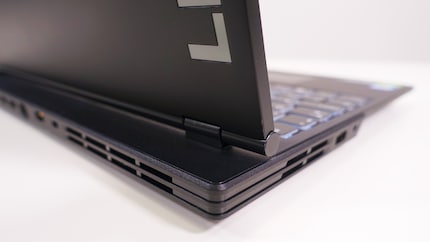
Another striking feature of this all-black notebook is that you can open up the display to almost 180 degrees. I also like the ventilation design, which directs the airflow from right to left through the case. This makes sure the device cools down enough if you’re using it on your lap or an uneven surface.
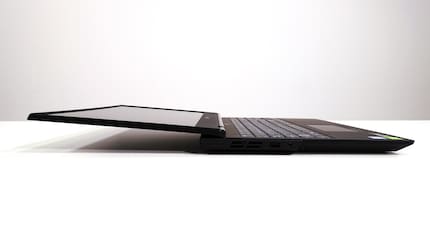
The legion is 36 cm wide, 26.7 cm deep and 2.6 cm high. On the left side, there's a USB 3.1 Type-A and a 3.5 mm jack connector; on the right side, there's a second USB 3.1 Type-A.
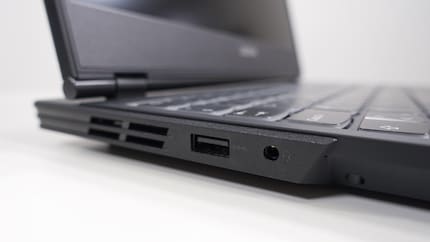
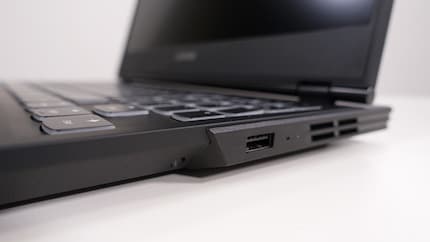
A USB 3.1 Type-C, a Mini DisplayPort, a third USB 3.1 Type-A, an HDMI Type A, a RJ45-LAN-Port, a mains connection and a Kensington lock are located on the back.
USB 3.1 Type-C, Mini DisplayPort, USB 3.1 Type-A, an HDMI Type A, RJ45-LAN-Port, mains connection and Kensington lock"]]
Gaming display with 144 Hz
The built-in 15.6-inch display has rather thin edges by today's standards. I measured 7 mm on the sides and 9 mm on the top. Only the lower edge is a bit larger with 4 cm – and that's where Lenovo integrated the 720p camera.
The IPS panel has a 1080p resolution and is anti-reflective. It doesn't boast HDR, but has a refresh rate of 144 Hz, which is something I never want to do without again.
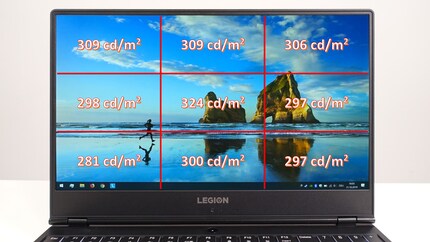
With an average of 302 cd/m², the display is bright enough. Only gaming or working in direct sunlight isn't possible. Compared to other notebook panels, this one is illuminated quite regularly. It's slightly brighter in the centre and seems to drop slightly at the bottom left. Yet, these irregularities are not visible by the eye.
I also measured the colour space coverage and the contrast with the x-rite i1Display Pro. With 87.5 percent sRGB, 63.2 percent Adobe RGB and 65.7 percent DCI P3, the display doesn't cover the colour space a graphic artist would need. But if you're not a professional graphic artist or if you're a gamer, you'll find that the colours are still extremely vivid. The static contrast is 970:1; the dynamic contrast is 3521:1.
Keyboard and touchpad
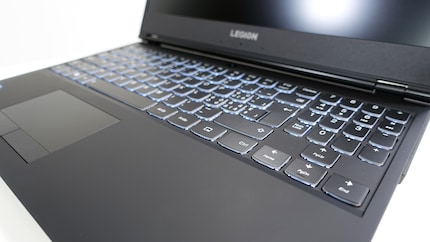
The material around the keyboard and touchpad is rubberised, which my palms are grateful for. The chiclet keyboard has a two-stage illumination and an unusually long key stroke of 2 mm. Pressing the keys, which are also slightly rubberised, needs comparatively little effort. As a result, typing feels rather soft, but the keys have a clear pressure point and the tactile feedback isn't comparable to a typical gaming keyboard. However, after gaming for a short while only, I was already getting used to it. The keyboard includes a number pad but no second Enter key.
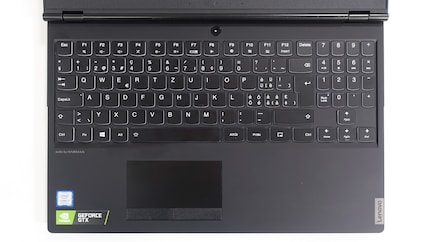
The touchpad dimensions are 10.2 cm × 5.2 cm and has a very smooth surface that offers enough space for multitouch and gestures. The pad reacts very precisely to my input. There are also two dedicated mouse buttons, which offer a distinct haptic and a discreet acoustic feedback.
Good notebook speakers
The loudspeakers are mounted on the front, but cannot be seen because the base is angled all around. The sound is surprisingly good for a notebook. The highs and mids have a very clean sound, although the latter are more dominant. When it comes to assessing bass, it depends a lot on what you're listening to. Deep voices as in the song «Mmm Mmm Mmm Mmm» by the Crash Test Dummies, sound almost perfect. Electro sound works well, too, but if you're listening to anything like metal or industrial, it's not a nice experience, to say the least.
Poor battery performance
The lithium-ion battery only has 57 Wh. But gaming notebooks usually don't last longer than one and a half hours without being connected to power supply even if they have a generous battery, so this isn’t quite as tragic.
Battery life with continuous YouTube streaming
When I streamed YouTube non-stop, I set the brightness of the display to the medium level. The device automatically shuts down after only 2 hours and 39 minutes. This is little, but not surprising because of the weak battery. To put this in perspective: MSI achieves 6 hours and 5 minutes with the GS65 Stealth Thin 8RF-292 and similarly performance-hungry hardware (Intel Core i7-8750H, Nvidia GTX 1070 Max-Q, 16 GB RAM) with an 82 Wh battery.
Battery life with maximum power and fan volume
To push all the hardware components to their limits, I ran the stress test HeavyLoad as well as FurMark with highest screen brightness at the same time. The battery died after 50 minutes. This means that you can't expect more than an hour of battery life when you're playing a graphically demanding game.
A word on noise emission: the notebook is not audible when it's running. Under full load, I measured 52 decibels from where I was sitting – one arm's length away from the display. This corresponds to the noise in a rather quiet office, which is why I never notice the notebook in our editorial office. If you measure the noise right at the fan of the notebook, it's 64 decibels. I measured with a Sony smartphone.
Battery life with office work
If I use the notebook as a mobile office, the battery will die after two and a half to three hours. However, the device isn’t designed for this purpose anyway. It’s far too heavy and has a bulky power supply (19.8 × 9.8 × 2.5 cm).
Processor
The Intel Core i7-9750H is a high-performance mobile 64-bit hexa-core high-end processor. It's the successor of the Intel Core i7-8750H and was launched as a refresh this year. Based on the Coffee Lake microarchitecture, Intel offers it with the improved third generation «14-nm++» process.
With up to two cores, the processor clocks at 2.6 to 4.5 GHz. If all six cores are used, it clocks at 2.6 to 4 GHz. The power consumption is 45 Watt TDP. The chip also features Intel's UHD Graphics 630 GPU.
Graphics card in the lower high-end range
The mobile Nvidia GeForce GTX 1660 Ti is a lower high-end processor and is based on the Turing architecture (TU116 chip). Compared to the faster RTX 2000 GPUs, it has no integrated ray tracing or tensor cores, but features 1536 shader units instead. It's manufactured in the 12 nm process and works with a frequency of 1455 to 1590 MHz and has 6 GB GDDR6 video RAM (connection via 192 bit interface). The power consumption is 80 watts.
The GTX 1660 TI is comparable to the mobile GTX 1070 in terms of performance, but the 1070 has a TDP of 115 watts.
Good performance for the price
Now it's time to get down to business: this notebook was designed to offer great performance, so let's see if it does. I measure the performance with various benchmarks for processor and graphics card as well as while gaming.
Processor power: Cinebench
Cinebench by Maxon lets you see how your PC performs when rendering Cinema 4D content. Processors with more cores will always deliver better results (except single core results). If you want to compare processors with Cinebench, you can only do this if both processors have the same number of threads.
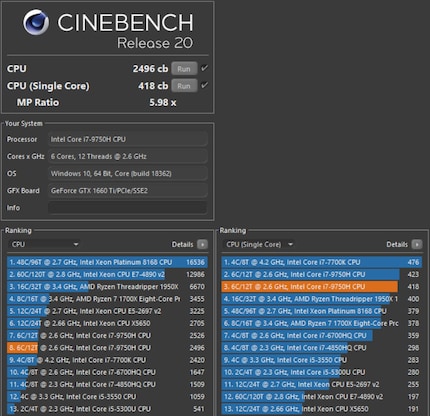
As you can see a line above the orange result, the notebook performs almost as well as the reference system with the same processor in both the multi-core and single-core tests. That speaks for Lenovo's cooling concept.
Gaming benchmarks
3DMark offers loads of benchmarks to test gaming PCs and laptops. To give you an overview, I tested 1080p-Gaming (Fire Strike), WQHD-Gaming (Time Spy) and UHD-Gaming (Time Spy Extreme).
| Benchmark | Resolution and DirectX-Version | Result Lenovo Legion | Result: mediocre gaming notebook |
|---|---|---|---|
| Fire Strike | 1920 x 1080 Pixel, DirectX 11 | 12 638 points
See: https://www.3dmark.com/3dm... | 10 850 points |
| Time Spy | 2560 x 1440 Pixel, DirectX 12 | 5668 points
See: https://www.3dmark.com/3dm... | 3879 points |
| Time Spy Extreme | 3840 x 2160 Pixel, DirectX 12 | 2535 points
See: https://www.3dmark.com/3dm... | 1785 points |
The Legion clearly performs better in all benchmarks than a mediocre gaming notebook with Intel Core i7-6820HK and Nvidia GeForce GTX 980.
Virtual Reality benchmarks
With the benchmarks defined by VRMark, I want to find out if this notebook is also suitable for Virtual Reality Gaming.
| Benchmark | What's tested? | Result Lenovo Legion | Required points (VR ready) |
|---|---|---|---|
| VRMark Orange Room | Performance of HTC Vive and Oculus Rift | 7653 points
See: https://www.3dmark.com/vrm... | 5000 points |
| VRMark Cyan Room | Performance with DirectX 12 | 5270 points
See: https://www.3dmark.com/vrm... | 3088 points |
| VRMark Blue Room | Performance for future hardware | 1702 points
See: https://www.3dmark.com/vrm... | 2972 points |
In this test, the Blue Room benchmark for future hardware is the only one the notebook doesn’t meet. If you’ve been thinking of using this notebook for gaming with the latest VR glasses, go ahead. This shouldn’t be a problem at all.
Gaming and FPS
Finally, I tested the performance with actual games by playing the in-game benchmark of Far Cry 5 and gaming Metro Exodus extensively.
The Far Cry 5 benchmark isn't a great reflection of a real game, because it lacks fast twists. But comparisons with already tested notebooks are possible. I set the graphics quality to the highest possible level at 1080p resolution.
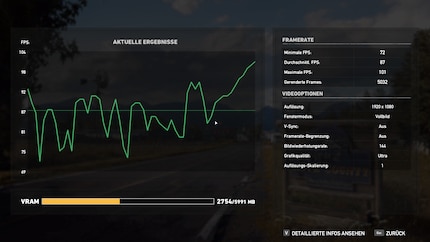
This result underlines the power of the built-in Nvidia GTX 1660 Ti. With 72 FPS, this gaming notebook surpasses some competitor products that have already been tested. With a Razer Blade 15 (Intel Core i7-8750H, Nvidia GeForce GTX 1060 Max-Q), I only achieved 61 FPS with the same quality settings. With a MSI notebook with GTX 1070 Max-Q and Intel Core i7-8750H, I measured 62 FPS. This goes to show that a good ventilation concept for gaming notebooks can sometimes result in better performance than a better graphics card.
When I gamed Metro Exodus at 1080p resolution (DirectX 12) on highest quality level, the game always ran smoothly. But I had to test it for a long time, because if I crawled through dark underground corridors, the FPS rate was visibly higher than in areas above the ground – the Taiga, for instance.
| Range | Ø FPS | Min. FPS | Max. FPS |
|---|---|---|---|
| Bad | 93 FPS | 66 FPS | 162 FPS |
| Good | 64 FPS | 37 FPS | 128 FPS |
Above ground, I reached an average of 64 FPS; underground it was 93 FPS. The frame rate never dropped below 37 FPS. Therefore, gaming on highest quality level, even without ray tracing, is no problem.
Conclusion: this device is definitely worth its money
When it comes to value for money, there's no beating Lenovo. Thanks to the graphics power of the lower high-end range, a powerful processor and enough RAM, the Lenovo Legion should be a great and loyal gaming notebook. On top of this, it boasts plenty of ports and an eye-friendly 144 Hz display. The screen comes without G-Sync and HDR, but that's understandable from a price point of view.
The only major disadvantage of this device is its short battery life. It won't last longer than an hour if you're playing a graphically demanding game. Having said that, other notebooks aren't suitable for gaming without plugging them in either. Therefore, I'm confident to say the Lenovo Legion is a good buy.
I find my muse in everything. When I don’t, I draw inspiration from daydreaming. After all, if you dream, you don’t sleep through life.
